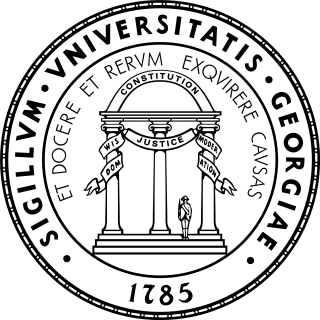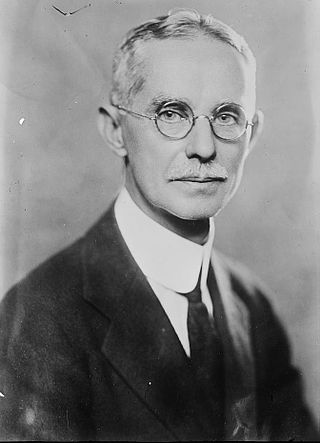Related Research Articles
Molecular biology is the study of chemical and physical structure of biological macromolecules. It is a branch of biology that seeks to understand the molecular basis of biological activity in and between cells, including biomolecular synthesis, modification, mechanisms, and interactions.

The University of Georgia is a public land-grant research university with its main campus in Athens, Georgia. Chartered in 1785, it is one of the oldest public universities in the United States. It is the flagship school of the University System of Georgia.

Flow cytometry (FC) is a technique used to detect and measure physical and chemical characteristics of a population of cells or particles.

Coomassie brilliant blue is the name of two similar triphenylmethane dyes that were developed for use in the textile industry but are now commonly used for staining proteins in analytical biochemistry. Coomassie brilliant blue G-250 differs from Coomassie brilliant blue R-250 by the addition of two methyl groups. The name "Coomassie" is a registered trademark of Imperial Chemical Industries.
The Bradford protein assay was developed by Marion M. Bradford in 1976. It is a quick and accurate spectroscopic analytical procedure used to measure the concentration of protein in a solution. The reaction is dependent on the amino acid composition of the measured proteins.

The bicinchoninic acid assay, also known as the Smith assay, after its inventor, Paul K. Smith at the Pierce Chemical Company, now part of Thermo Fisher Scientific, is a biochemical assay for determining the total concentration of protein in a solution, similar to Lowry protein assay, Bradford protein assay or biuret reagent. The total protein concentration is exhibited by a color change of the sample solution from green to purple in proportion to protein concentration, which can then be measured using colorimetric techniques. The BCA assay was patented by Pierce Chemical Company in 1989 & the patent expired in 2006.
The Lowry protein assay is a biochemical assay for determining the total level of protein in a solution. The total protein concentration is exhibited by a color change of the sample solution in proportion to protein concentration, which can then be measured using colorimetric techniques. It is named for the biochemist Oliver H. Lowry who developed the reagent in the 1940s. His 1951 paper describing the technique is the most-highly cited paper ever in the scientific literature, cited over 300,000 times.

The Journal of Biological Chemistry (JBC) is a weekly peer-reviewed scientific journal that was established in 1905. Since 1925, it is published by the American Society for Biochemistry and Molecular Biology. It covers research in areas of biochemistry and molecular biology. The editor is Alex Toker. As of January 2021, the journal is fully open access. In press articles are available free on its website immediately after acceptance.
The College of Public Health (CPH) is a college within the University of Georgia (UGA) in Athens, Georgia, United States.
The University of Georgia College of Veterinary Medicine is a college within the University of Georgia (UGA) in Athens, Georgia, United States and is a top 10 ranked veterinary school.

Charles Holmes Herty Sr. was an American academic, scientist, and entrepreneur. Serving in academia as a chemistry professor to begin his career, Herty concurrently promoted collegiate athletics including creating the first varsity football team at the University of Georgia. His academic research gravitated towards applied chemistry where he revolutionized the turpentine industry in the United States. While serving as the president of the American Chemical Society, Herty became a national advocate for the nascent American chemical industry and left academia to preside over the Synthetic Organic Chemical Manufacturers' Association (SOCMA) and the Chemical Foundation. He was also instrumental in the creation of the National Institutes of Health. Towards the end of his career, Herty's research and advocacy led to the creation of a new pulp industry in the Southern United States that utilized southern pine trees to create newsprint.

Dame Janet Maureen Thornton, is a senior scientist and director emeritus at the European Bioinformatics Institute (EBI), part of the European Molecular Biology Laboratory (EMBL). She is one of the world's leading researchers in structural bioinformatics, using computational methods to understand protein structure and function. She served as director of the EBI from October 2001 to June 2015, and played a key role in ELIXIR.
Richard D. Cummings is an American biochemist who is the S. Daniel Abraham Professor of Surgery at Beth Israel Deaconess Medical Center and Harvard Medical School in Boston, Massachusetts. He also the chief of the division of surgical sciences within the department of surgery. He is the director of the Harvard Medical School Center for Glycoscience, director of the National Center for Functional Glycomics, and also founder of the Glycomics Core at BIDMC. As of 2018 Cummings is also the scientific director of the Feihi Nutrition Laboratory at BIDMC. Before moving to BIDMC/HMS, Cummings was the William Patterson Timmie Professor and chair of the department of biochemistry at Emory University School of Medicine in Atlanta, Georgia from 2006 to 2015. At Emory, Cummings was a founder in 2007 of the Emory Glycomics Center.
The Odum School of Ecology is a school within the University of Georgia and the successor of the UGA Institute of Ecology. It is named after Eugene Odum, renowned UGA biologist, the father of ecosystem ecology, and the founder of the Institute.
Ulrich K. Laemmli, real name Lämmli, is a Professor in the biochemistry and molecular biology departments at University of Geneva. He is known for the refinement of SDS-PAGE, a widely used method for separating proteins based on their electrophoretic mobility. His paper describing the method is among the most cited scholarly journal articles of all time. His current research involves studying the structural organization of nuclei and chromatin within the cell.
Virus quantification is counting or calculating the number of virus particles (virions) in a sample to determine the virus concentration. It is used in both research and development (R&D) in academic and commercial laboratories as well as in production situations where the quantity of virus at various steps is an important variable that must be monitored. For example, the production of virus-based vaccines, recombinant proteins using viral vectors, and viral antigens all require virus quantification to continually monitor and/or modify the process in order to optimize product quality and production yields and to respond to ever changing demands and applications. Other examples of specific instances where viruses need to be quantified include clone screening, multiplicity of infection (MOI) optimization, and adaptation of methods to cell culture.
A thermal shift assay (TSA) measures changes in the thermal denaturation temperature and hence stability of a protein under varying conditions such as variations in drug concentration, buffer pH or ionic strength, redox potential, or sequence mutation. The most common method for measuring protein thermal shifts is differential scanning fluorimetry (DSF) or thermofluor, which utilizes specialized fluorogenic dyes.
A ligand binding assay (LBA) is an assay, or an analytic procedure, which relies on the binding of ligand molecules to receptors, antibodies or other macromolecules. A detection method is used to determine the presence and extent of the ligand-receptor complexes formed, and this is usually determined electrochemically or through a fluorescence detection method. This type of analytic test can be used to test for the presence of target molecules in a sample that are known to bind to the receptor.
Wayne Allen Parrott is a professor of crop sciences in the University of Georgia's College of Agricultural and Environmental Sciences in Athens. Since 2017, he has also been an Elected Fellow of the American Association for the Advancement of Science.
Adam O. Anderson is an American football linebacker. He previously played college football for the Georgia Bulldogs.
References
- 1 2 3 4 5 American Men & Women of Science: A Biographical Directory of Today's Leaders in Physical, Biological, and Related Sciences (23 ed.). Gale Group. 2007. p. 756 (v. 1). Retrieved 12 March 2015.
- ↑ Zagorski, Nick (February 2011). "Ruma V. Banerjee and Stephen W. Ragsdale: deciphering sulfur and carbon metabolism". ASBMB Today. Archived from the original on 2015-04-02.
- ↑ Bradford MM (May 1976). "A rapid and sensitive method for the quantitation of microgram quantities of protein utilizing the principle of protein-dye binding". Anal. Biochem. 72 (1–2): 248–54. doi:10.1016/0003-2697(76)90527-3. PMID 942051. S2CID 4359292.
- ↑ "Protein-assay reagent and method". US Patent Office. Retrieved 15 March 2010.
- ↑ Van Noorden, Richard; Maher, Brendan; Nuzzo, Regina (29 October 2014). "The top 100 papers". Nature. 514 (7524): 550–553. Bibcode:2014Natur.514..550V. doi: 10.1038/514550a . PMID 25355343.
- ↑ Garfield, Eugene (12 February 1990). "The most cited papers of all time" (PDF). Current Comments. 13 (7): 2–14.
- ↑ Garfield, Eugene (1998). "THE USE OF JOURNAL IMPACT FACTORS AND CITATION ANALYSIS FOR EVALUATION OF SCIENCE". The Scientist.
- ↑ "Miss Janet Holliday weds Marion Bradford Saturday". Rome News-Tribune. June 13, 1971. p. 1-D.
- ↑ "UGA scientist revolutionized biochemical research". Athens Banner-Herald. 27 October 2019. Retrieved 14 Apr 2020.
- ↑ "Marion McKinley Bradford". Jackson Funeral Service.
- ↑ Freund, Sarah (27 October 2019). "UGA researcher honored with Distinction Award". Online Athens. Athens Banner-Herald. Retrieved 13 Apr 2020.